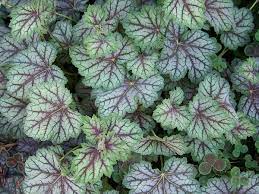This plant is native to North America (including Arkansas). Due to its colorful foliage you may recognize it as a popular ornamental garden plant . Few recognize it as an important, old-time herbal wound remedy due to it’s powerful astringent properties.
The leaves spring directly from the root, on very long and downy petioles with dilated margins; roundish, five inches by three, usually margined into seven short lobes with short teeth. Flowers small, on scapes two to three feet high, which rise directly from the root, and are glandular and somewhat hairy; in narrow and terminal panicles; calyx small, five-cleft, bell-shaped, cohering at the base with the ovary; corolla very small, of five purplish petals inserted on the margins of the calyx; stamens twice the length of the petals, with yellow filaments and globular red anthers. June. This plant is common in rocky woodland throughout the United States. It has a knotty and very hard root stock.
Traditional Uses
Wound Healing: Heuchera species, including Heuchera americana, have been used traditionally for their potential wound healing properties. The leaves or aerial parts of the plant have been applied topically to cuts, wounds, and skin irritations to promote healing and alleviate inflammation.
Astringent: It has been applied topically to tighten and tone tissues, reduce inflammation, and help alleviate minor skin irritations.
Styptic: William Cook wrote in the 1869 “THE PHYSIOMEDICAL DISPENSATORY“: This root is intensely astringent, with a modicum of stimulating properties. It is too powerfully drying to be suitable for internal use, except in such passive conditions of the bowels as are connected with hemorrhage and coliquative diarrhea suddenly following typhus; when it may be combined with a stimulant and used by injection [enema]. Its powder is employed locally as a styptic in wounds, piles, and other hemorrhages from small vessels. It is a reliable article in such cases; and has also been applied in foul and indolent ulcers, in company with Xanthoxylum or other stimulant. Combined with hydrastis in excess, it will make a good injection for depressed and offensive leucorrheal discharges and excoriated cervix uteri of the malignant grade. The dose of this article is from three to five grains, every second hour. It is usually given by infusion, or boiled in milk with geum virginianum and a demulcent.
Antimicrobial Activity: Some studies have investigated the antimicrobial activity of Heuchera species. In a study published in the Journal of Ethnopharmacology, extracts of Heuchera americana showed significant antimicrobial activity against various microorganisms, including bacteria and fungi. Schempp, C. M., et al. (2002). Heuchera species—Emerging antimicrobial and anti-inflammatory drugs from an herbal medicinal plant. Journal of Ethnopharmacology, 81(2), 331-334.

